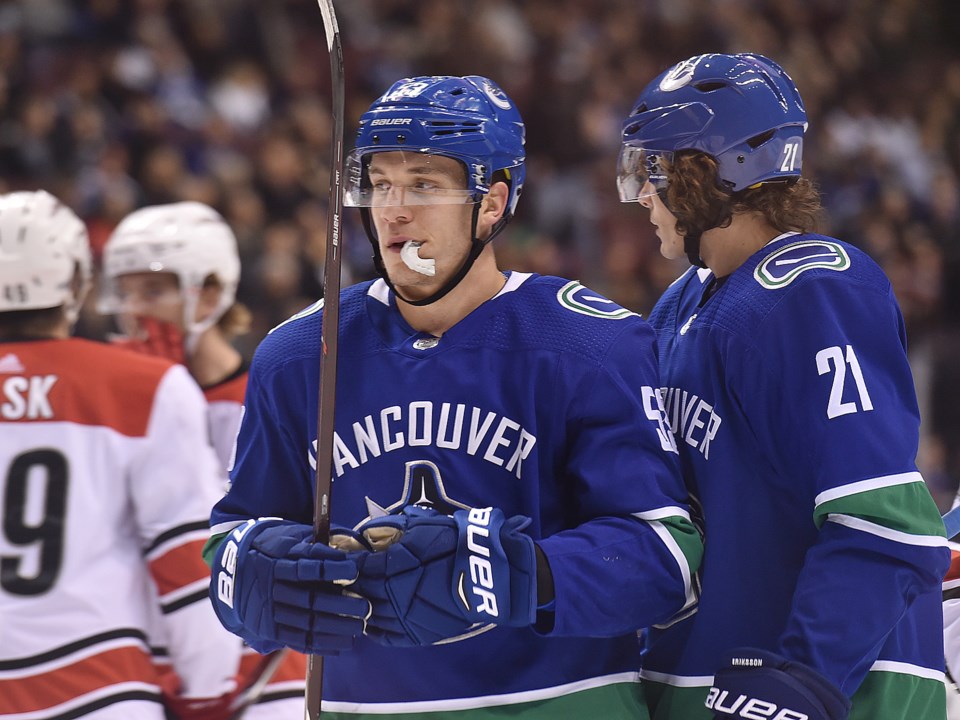The Paper Feature is a weekly column and sidebars that appears in the print edition of the Vancouver Courier newspaper. Track it down!
When Henrik Sedin retired, the Canucks didn’t just lose their franchise leader in points; they lost their captain.
The Canucks need to replace more than Henrik and Daniel Sedin’s point production, but their leadership as well. Neither will be easy. Not only are the twins the two best players in franchise history, they’re two of the best people, whose commitment to the community is just as impressive as their commitment to constantly getting better on the ice.
In one sense, the captaincy itself doesn’t matter. The players in the room know who the leaders are and a letter on a sweater doesn’t change that.
“You don’t need a letter to lead,” said Canucks head coach Travis Green. “For me, you lead in your own way, whether you’re a rookie or 15-year veteran...It comes out in how you practise, how you train in the off-season and how you treat your teammates and how you react in a game where you personally didn’t play that well.”
Instead, the captaincy is more of an outward-facing role. The captain is the player who speaks to the referees, talks to the media, even after tough losses when no one wants to face the music, and is a representative of the team in the community. In essence, the captain is a combination of in-the-room leadership and a number of duties that have nothing to do with actually leading a hockey team.
So who will be the next captain of the Canucks?
1 | Give it to an experienced veteran
Whether it’s a temporary role — think of Roberto Luongo being named captain after Markus Naslund before Henrik took up the “C” — or a more permanent position, the Canucks could name one of their veterans captain.
The longest-serving Canuck is now Alex Edler, and he’s worn an “A” for a few years. He commands a lot of respect in the room, but the issue is that he’s a little too quiet and reserve for an outward-facing role like the captaincy.
Other options would be Brandon Sutter and Erik Gudbranson, both signed for the next three years. Gudbranson was slated to be a future captain in Florida before he was traded to the Canucks.
2 | Rotate the captaincy between several players
For their first nine seasons, the Minnesota Wild rotated the captaincy every month among four or five players. The Canucks could take the same approach for a season or two while their young players develop.
This would allow both veterans and youth to take on the captaincy at different times. And think of the extra jerseys you could sell with multiple captains! Okay, maybe that’s less of a concern.
3 | No captain, just alternates
This isn’t that unusual, particularly for younger teams. The Toronto Maple Leafs haven’t had a captain since Dion Phaneuf was traded in 2016. The Vegas Golden Knights didn’t need a captain for their impressive inaugural season. The Arizona Coyotes and Buffalo Sabres also went without captains.
The upside is that no one player gets all the pressure of the captaincy on their shoulders, but you don’t have the gimmicky aspect of a rotating captaincy. The Canucks would just need to name a group of alternate captains — a mix of youth and veterans — as their leadership group.
4 | Just give it to Bo Horvat already
Ever since he was drafted, Horvat has been pegged as the next captain of the Canucks, and for good reason. He’s a born leader. He trains hard, leads by example with his effort on the ice, is calm and poised with the media, and never gets either too high or too low. He has the right temperament and maturity to be a captain, even at a young age.
Really, he’s not that young. Horvat is 23, much older than when Connor McDavid, Sidney Crosby, and Jonathan Toews were named captains of their teams.
Horvat is ready. Name him the captain.
Stick-taps and Glove-drops
I’m dropping the gloves with Elias Pettersson’s left thumb. Pettersson fractured his thumb, ending his World Hockey Championship tournament just as he was starting to get comfortable and contribute. Pettersson will undergo surgery, but shouldn’t miss much, if any, training time this summer.
A tap of the stick to Mark Scheifele, who has been unreal for the Winnipeg Jets in his first playoff run. Scheifele leads the postseason in goalscoring with an absurd 14 goals in 15 games.
Big Numbers
117 - No player started more shifts in the defensive zone in the playoffs than former Canuck Nick Bonino: 117 d-zone faceoffs, compared to just 19 in the offensive zone. His Predators actually outscored their opponents with him on the ice despite his extreme usage.
8.6 - The Winnipeg Jets are the biggest and toughest team remaining in the playoffs, but they’re also the most disciplined. They’ve averaging 8.6 penalty minutes per game. Compare that to the smaller and speedier Lightning, who are averaging 13.9 penalty minute per game in the playoffs.



